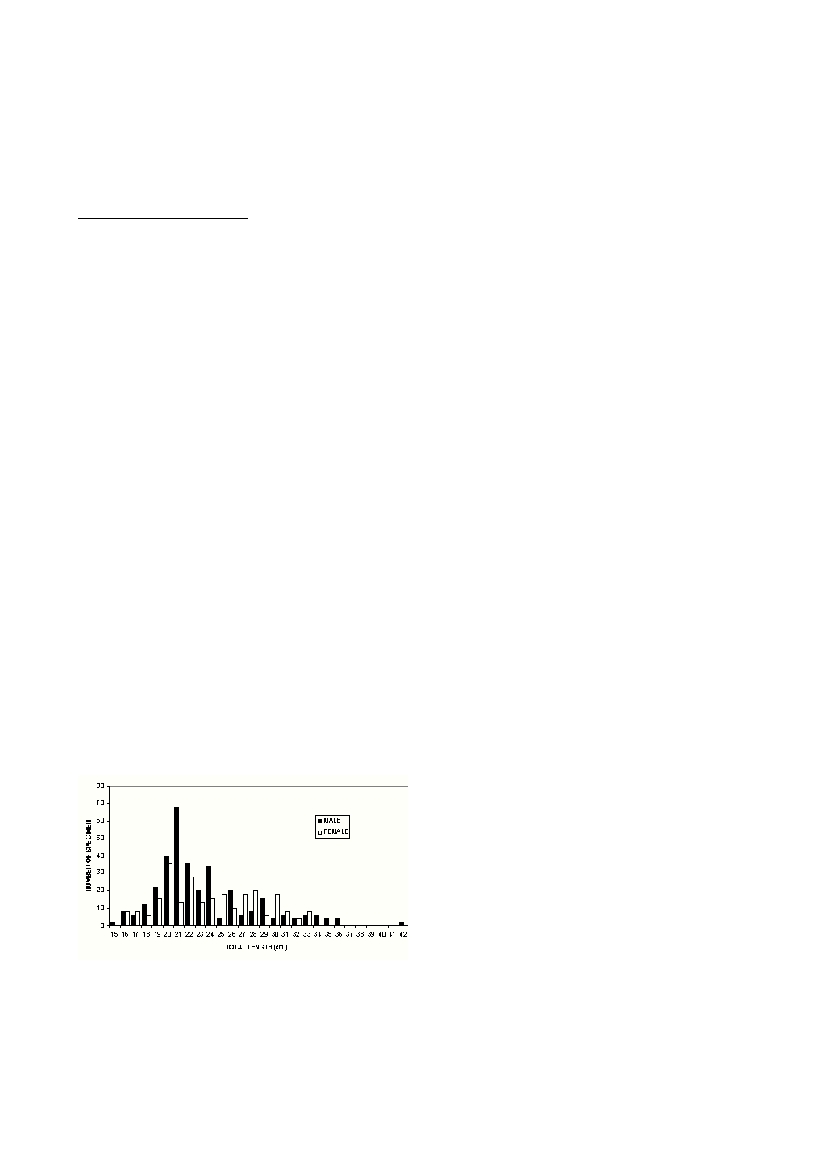Rapp. Comm. int. Mer Médit., 36,2001
324
Introduction
Common spiny lobster,Palinurus elephas(Fabricius, 1787), is
known from the western and central Mediterranean up to coasts of
Turkey, while in the Atlantic it occurs from the British Isles to the
Azores (1). In the Eastern Adriatic it is distributed throughout the
entire coast at depths from 20 to 120 meters, but it is rare in the
Northern Adriatic. Main areas of its distribution and in the same time
its most important fishing areas are southern sides of distant islands
(2).
According to croatian fishing legislation lobster fishing season is
from 1
st
May to 31
st
August and it should be performed by lobster pots
with minimum mesh size of 110 mm or by lobster gillnets with mini-
mum mesh size of 240 mm. Because of deficient fishing legislation, in
lobster fishing areas, trammel nets and, especially, gillnets with 120
mm mesh size, originally used for fishing of cartilaginous fish (3), are
also used for lobster fishing. Futhermore, lobster gillnets (240 mm
mesh size) are mainly abandoned and replaced by 120 mm mesh size
gillnets. Although there is no proper fishery statistics regarding lobster
landings, different sources (fishermen, fishery market...) indicated
decline in lobster landings during the last decade, with inadequate gill-
nets as presumed main reason for that situation. Accordingly, research
has been carried out in order to evaluate impact of these gillnets on
lobster population.
Material and methods
Research has been carried out in different lobster fishing areas of
southern and central eastern Adriatic during 1998. and 1999. Gillnet
with mesh size of 120 mm, height of 10,5 meshes and 0,33 hanging
ratio has been used. Total length (TL) from tip of the rostrum to the
end of telson in mm, carapace length (CL) in mm, weight (W) in
grams and sex has been measured for each lobster specimen.
According to previous researches (4; 5) and fishery legislation, 28 cm
of total length is length at first maturity and minimum landing size for
common spiny lobster in the Eastern Adriatic. Length-weight relation-
ship is analysed according to following equation: W= a TL
b
.
Results and discussion
Total number of 594 specimens was caught and analysed. Fig.1
shows length frequency distribution of common spiny lobster, both
males and females, according to total length. Length range of caught
specimens was between 12 and 42 cm of total length, while weight
range was between 48 and 2228 g. 477 specimens were under 28 cm
of total length, which represents 80,30 % of immature specimens.
Figure 1: Length frequency distribution of common spiny lob-
ster.
Length-weight relationship of common spiny lobster is presented
with following equation :
W= 0,033924 TL
2,905
(r= 0,958),
while for males is : W= 0,039437 TL
2,860
(r= 0,969),
and for females is : W= 0,041658 TL
2,832
(r= 0,955).
Sex ratio for common spiny lobster is 1,3:1 in favour of females.
Only seven berried females were caught (0,011 %), mainly during
the end of August, which proves that berried females occur mainly
from September onwards in the Adriatic (6), what is the same period
as in the Mediterranean (7). Therefore, closed season falls during
spawning period, which is prerequisite for better protection and man-
agement of lobster.
Recent investigations shows that length at first maturity for com-
mon spiny lobster in Mediterranean and Atlantic is 82-86 mm CL (7)
what is in relation with obtained CL of lobsters with 28 cm TL in the
Eastern Adriatic. This means that minimum landing size of 28 cm TL
for lobster is in accordance with length at first maturity. Comparison
of investigated gillnets with lobster gillnets shows significant differ-
ences. Mesh size of lobster gillnets is twice of mesh size used in inves-
tigated gillnets. Furthermore, hanging ratio of investigated gillnets (E=
0,33) in relation to hanging ratio of lobster gillnets (E= 0,67) is sig-
nificantly unfavourable for species with body characteristics such as in
lobster.Accordingly, result of these gear characteristics is high per-
centage of immature specimens (80,30%) in catches. These results
show that impact of gillnets on lobsters is very severe. Therefore, in
order to prevent overfishing of lobster, which signs were already pre-
sent, and to allow normal reproduction of species, fishing with these
gillnets should be forbidden at the lobster fishing areas.
References
1 - Fischer W. (ed.), 1973. FAO species identification sheets for fishery
purposes.Mediterranean and Black Sea(fishing area). Volume 2.
2 - Grubisic F. 1954. Jastog i hlap. Mala ribarska biblioteka, Rijeka:
pp.39.
3 - Cetinic P. and Soldo A., 1999. Some basic characteristics of Croatian
marine fisheries and its legal regulation. Acta Adriatica, 40 (Suppl.):
91-97.
4 - Dulcic J., Cetinic., Kraljevic M., 1995. Neki bioloski parametri
jastoga, Palinurus elephas Fabr., s podrucja otoka Palagruze. Morsko
ribarstvo, 41 (1) : 1-4.
5 - Cetinic P., Dulcic J., Bozanic J., 1997. Ocjena lova jastoga, Palinurus
elephas(Fabricius, 1787), vrsama u srednjem Jadranu. Ribarstvo, 55 (1):
1-9.
6 - Gamulin T., 1955. Contribution à la connaissance de l’écologie de la
langouste (Palinurus vulgarisLatr.) dans l’Adriatique. Acta Adriatica, 7
(9): pp.20.
7 - Hunter E. 1999. Biology of the European spiny lobster,Palinurus
elephas(Fabricius, 1787) (Decapoda, Palinuridea). Crustaceana, 72
(Part6): 545-565.
THE LOBSTER FISHERYWITH GILLNETS IN THE EASTERN ADRIATIC
A. Soldo *, P. Cetinic, J. Dulcic, I. Jardas, A. Pallaoro
Institute of Oceanography and Fisheries, Split, Croatia - soldo@izor.hr
Abstract
Lobster fishery in the Eastern Adriatic should be performed with pots and lobster gillnets, but other gillnets and trammel nets are also used.
In?uence of gillnets, with inadequate mesh size, on lobster has been evaluated according to length frequency of caught lobsters, percentage
of immature specimens, sex ratio and length-weight relationship. According to obtained results, impact of gillnets with inadequate mesh
size on lobster is very harmful, so lobster fishing with such gillnets should be forbidden, in order to prevent overfishing and extinction of
this species in the Eastern Adriatic.
Keywords : fisheries, Adriatic Sea

